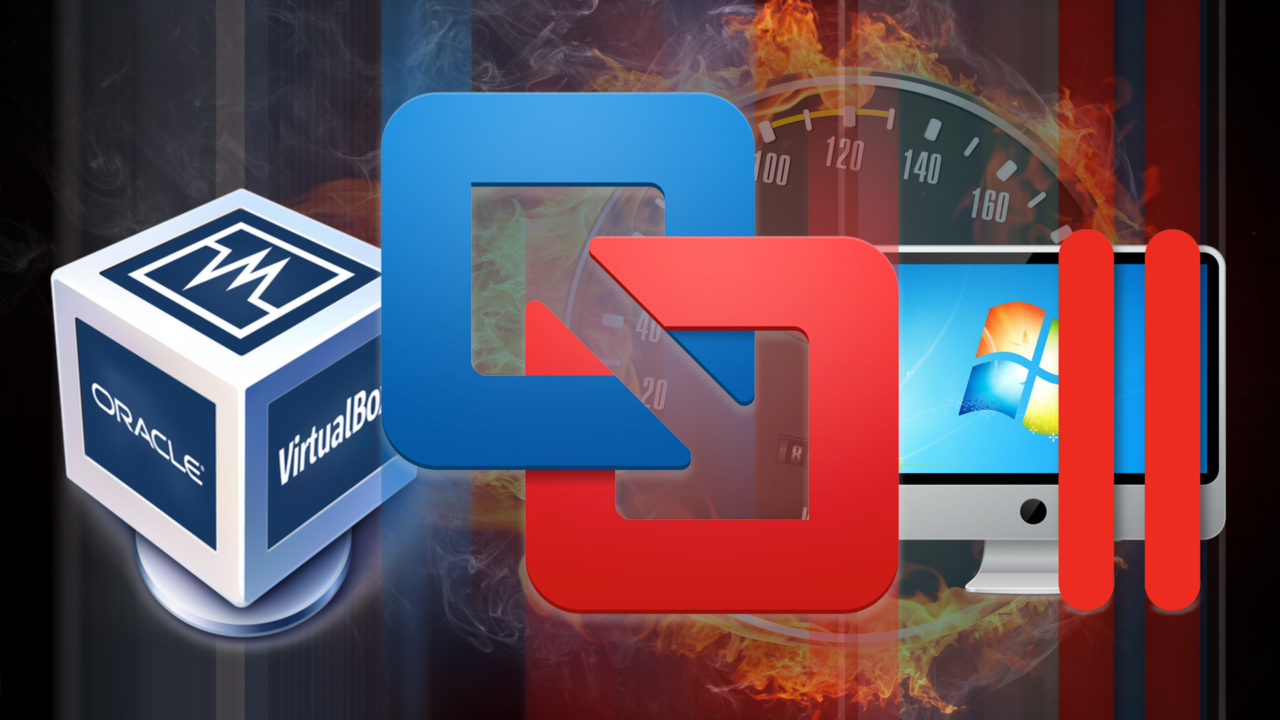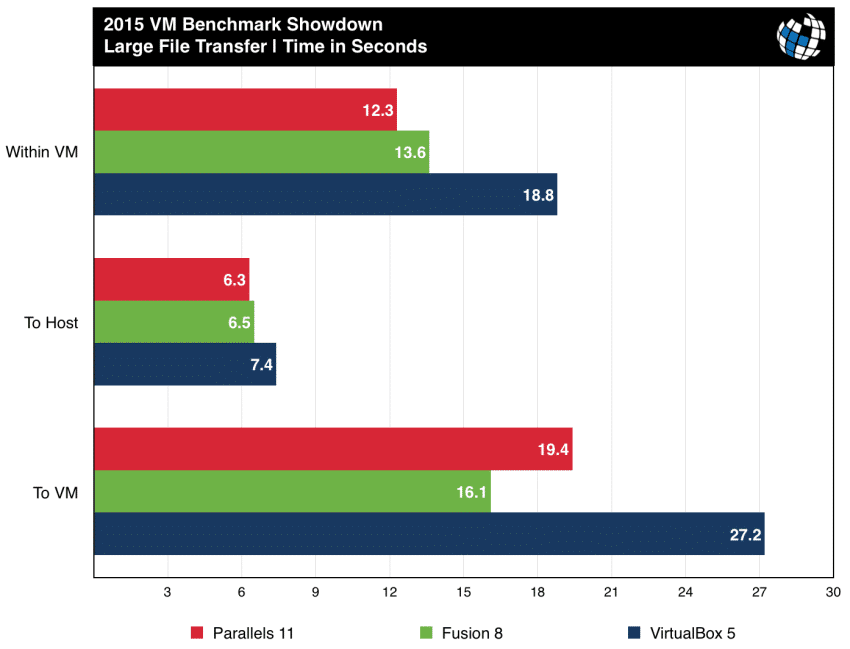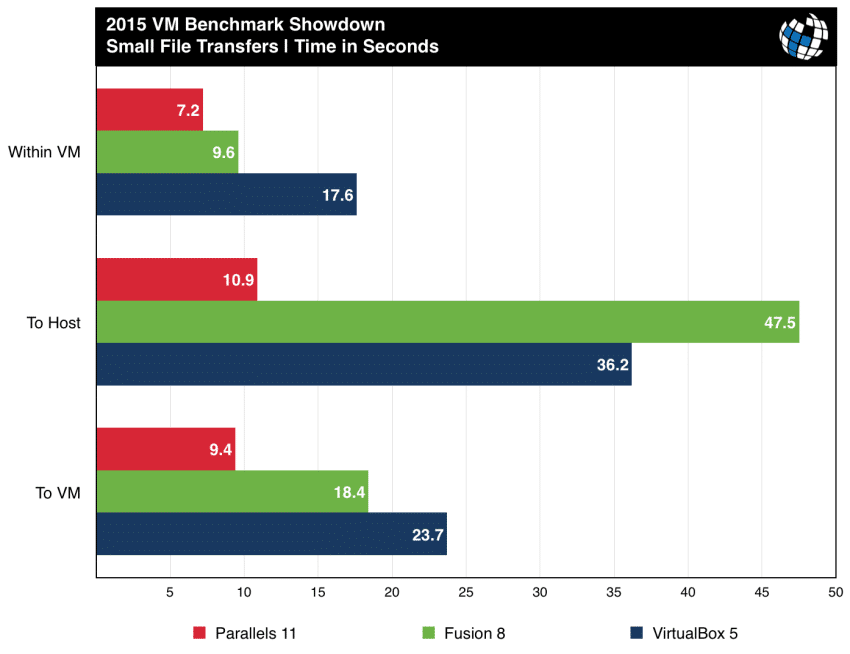2015 VM Benchmarks: Parallels 11 vs. Fusion 8 vs. VirtualBox 5

File Transfers
An important factor in the user experience of any virtual machine is file transfer performance. As we discovered last year, free virtualization software like VirtualBox really lags behind commercial options from Parallels and VMware when it comes to file management, and depending on your workflow, that could be a deal breaker.
This test (like the Virtual Machine Management test later on) is a little different in that it doesn’t include Boot Camp performance. This is because we’ll be testing the process of copying files between the VM and the host operating system, and that activity has no equivalent for a native Windows installation.
Our file tests are divided into two groups: a large file transfer (a single 4GB Windows 10 installation ISO) and a small file transfer (4,096 4KB files). The numbers in the chart represent the time in seconds that it took for each transfer, so a lower score is better here.
Note that unlike our standard tests that rely on computer-generated results, these tests were measured manually with a stopwatch. As a result, we performed each test five times instead of the usual three iterations, in order to minimize the impact of human error. Also note that we rebooted the VMs in between each test to avoid any operating system caching that could artificially improve the times.
Starting off with the large file transfer, we see that the platforms trade victories based on the type of transfer. In the “Within VM” test, which measures a transfer from one location on the VM’s virtual drive, Parallels beats Fusion by a little more than 1 second. When it comes to file transfers between the host and guest operating systems, the “To Host” test (a file transfer from the Windows VM to OS X) shows Fusion and Parallels to be about equal, while Fusion wins by about 3 seconds in the “To VM” test (a file transfer from OS X to the Windows VM).
But file transfer speed can vary greatly depending on the number and types of files, so we wanted to see what would happen if we threw a huge number (4,096) of small 4KB files at our VMs.
With small files, there’s no competition. Parallels 11 wins by a landslide. Things are mostly competitive for transfers within a VM, with Fusion taking about 2.5 seconds longer than Parallels, but when it comes to transfers between the host and the guest operating systems, things fall apart for Fusion. Fusion 8 takes a lengthy, but tolerable, 9 seconds longer to transfer our small files from OS X to the Windows VM, but an astounding 36 seconds longer (a 335 percent increase) when transferring from the Windows VM to OS X. This score is 11 seconds worse than VirtualBox.
We first thought this result was due to a bug or configuration issue, but we verified that there were no configuration factors at play — e.g., encryption, indexing, caching — that would explain it as abnormal. Factor in the poor performance of Fusion 7 on the same test and the conclusion is that Fusion just isn’t very good at transferring lots of small files to the host operating system. Your unique workload and needs will determine if this is a deal breaker when it comes to Fusion vs. Parallels.
It’s important to note that the specific times reported here are all based on the relatively fast flash storage found in all recent MacBooks. The performance of virtual machines stored on traditional mechanical hard drives, or on external storage arrays, was not tested, and may reveal different trends or limitations between the various virtualization platforms.
Table of Contents
[one_half padding=”0 5px 20px 0″]
1. Introduction
2. Test Setup & Methodology
3. Geekbench
4. 3DMark
5. FurMark OpenGL
6. Cinebench R15
7. PCMark 8
8. Passmark PerformanceTest
[/one_half]
[one_half_last padding=”0 0px 20px 5px”]
9. Video Encoding
10. File Transfers
11. USB 3.0 Speed
12. Virtual Machine Management
13. Battery Life
14. Mac Pro: Gaming
15. Mac Pro: CPU
16. Conclusions
[/one_half_last]




















28 thoughts on “2015 VM Benchmarks: Parallels 11 vs. Fusion 8 vs. VirtualBox 5”
* ESXi with macOS guest
Has anyone else notices that Fusion runs a bit “hotter” than Parallels? I find that opening up Fusion to Win 7 or Win 10 automatically gets the temp up at least 20 degrees (F) or so on my rMBP (2015) set for 2 of 4 cores and 8 of 16 gigs of the RAM allocated. This is very disappointing. I have zero issue with the VMware offering (used it years ago) save for this need to use more energy than Parallels. I only use Windows for a couple of apps but I would be worried about adding a more CPU intensive app if heat is generated like this at a greater scale.
Any thoughts or confirmation of Fusion running hotter?
On my current setup it seems to take an eternity for the memory on my Windows VM to be filled with all the data it needs (I need to have a SQL server and a related application running on my Windows OS). Are there any good metrics on how long it takes for the OS to load up files from the drive into memory?
PS: Hard drive is a traditional drive, system report describes as APPLE HDD ST1000DM003
1) The exact models and specifications for the testing hardware are listed in the article, along with the methodology used for the tests. You’ll find this information on the ironically named “Test Setup & Methodology” page.
2) We submitted our results and methodology to both Parallels and VMware to give each company a chance to respond. Neither company claimed that our testing procedure or the configuration of our virtual machines were incorrect or unfair.
3) Other than providing licenses for both Fusion 8 and Parallels Desktop 11 for our tests, TekRevue was not remunerated by either company in any way, nor were the tests conducted or guided by anyone outside of TekRevue.
4) These products, and our review, are primarily targeted at consumers. That’s why we used both a MacBook Pro and mid-level Mac Pro in the tests. If you’d like us to conduct future tests on your custom Mac Pro (I say “custom” because the Mac Pro you describe in your other comment — 2 x 6-core hyperthreaded 3.33GHz — is not a configuration Apple ever shipped), then please send it to us and we’ll be happy to do the additional testing. In general, however, I hope you’ll agree that your specific configuration isn’t applicable to ~99% of users.
I didn’t try any hard-core games, as I don’t use the machine for that purpose. However, multiple version of Windows (XP, 7, 10) ran faster and smoother overall in Parallels for general use in my experience.
Having said that, I had some trouble with Parallels recognizing certain USB devices that Fusion did not have trouble with. Complained about it to Parallels, and they’ve recently pushed out a new release that addressed and fix those problems, so I appreciate their customer support.
Good article, thanks!
VM Capabilities
VM Capabilities
You are forgetting one major thing: Fusion and Parallels are designed to integrate Windows with OS X. VirtualBox is designed to virtualise an entire machine as if it were 100% separate, no integration at all.
It would be worth seeing how Parallels & Fusion (or even Virtualbox, but I assume it’ll look absolutely terrible as far as performance goes) similarly act under a multi-chip host environment to see how they negotiate allocations between multiple physical chips, as opposed to threads all being sent to the same chip.
I’m an enthusiast of fusion 8 and a user fro version 5. This last release is a great goal!
Overall content on Tekrevue is very solid. I enjoy reading OS X tips mostly.
Thanks guys!:)